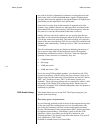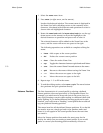
5-13
Nº40 Media Console Menu System
over slope that ought to be used. Thus, you have independent
control over the crossover characteristics for each of the following
groups:
• Front left and front right
•Center
• Surround left and surround right
• Any surround back channel(s) you have elected to use.
For each of these logical groups of speakers, you can select a cross-
over frequency from among the following:
• Full range (e.g., not “crossed over” at all)
• 30 Hz to 100 Hz, in 10 Hz increments.
Similarly, for each of these logical groups of speakers, you can select
a crossover slope of either:
• 12 dB per octave, THX
•18 dB per octave.
If you are using THX-certified loudspeakers, you should use the
THX crossover frequency of 80 Hz, and a high pass crossover slope
of 12 dB/octave. These options are listed as “80 Hz, THX” and “12
dB/oct, THX” in the menu system, as a reminder.
Caution In extreme cases, you can damage center and surround speakers
speakers by sending them lower-frequency information than they
are designed to handle.
These crossover settings are not required in order to take advantage
of the Home THX processing mode. Rather, they are designed to
integrate THX-certified loudspeakers into the system as seamlessly
as possible.
Slope
By default, the subwoofer receives any low frequency information
that cannot be handled by the other speakers in the system, as
defined by the crossover settings for those speakers. This approach
is sometimes called a “complementary” crossover, in that the
output of the subwoofer is designed to complement that of all the
other channels perfectly, to ensure that all information is
reproduced.
However, some subwoofers have their own built-in crossovers that
cannot be bypassed. Since it is usually inadvisable to have multiple
crossovers in series with each other, the Nº40 also provides a “full
range” option for the subwoofer output. This full range output is


















